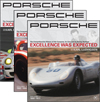|
Porsche: Excellence Was Expected
Price: TBD
|
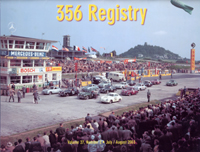
356 Registry - July/August 2003
Karl Ludvigsen
by Gordon Maltby
If my 1978 copy of "Excellence was Expected" was a Porsche, it would be described as a "driver" with a lot of miles on the clock. Its well-thumbed condition is a testament to the importance I place on its contents and the frequency with which I use it. (Notice I say "use" and not "read." Even though the stories are told masterfully and the material is anything but dry data, it's such a valuable reference tool that I end up reading only snippets at a time while looking for specific answers. But it's also an entertaining evening read.)
I acquired my copy in 1985, about the time it started down the long path to "out-of-print." I remember when the book distributor I was working for at the time had them on sale at half off the then-princely sum of $64.95. There have been moments in the last few years when I wished I had stocked up, as the going rate for a copy these days is $200-$400. Unfortunately for those still wanting to cash in their vintage models, the market may soon become a little softer, as a new edition is finally on its way.
Through Bentley Publishers and my contact there, Ari Miel, I received an advance copy to review and had an opportunity to speak at length with the author, Karl Ludvigsen, about his background and the events that led to his becoming?in my eyes and the eyes of many other Porschephiles?the premier biographer of the Stuttgart sports car maker.
The preface to the original edition of Excellence Was Expected is presented at right, courtesy of the author and the publisher. I believe it gives a comprehensive overview to Mr. Ludvigsen's connection with Porsche, but I was curious about, as Paul Harvey calls it, "the rest of the story" I am pleased to share with our readers some of the the highlights of a conversation with a most remarkable man, Karl Ludvigsen.
In spite of the name (which is Danish), Karl Ludvigsen can be called as all-American as any of us. Growing up in Michigan where his father was an executive at Fuller transmission, lie read about cars of all kinds, and studied German and Latin in high school. While studying engineering during two years at MIT, a fledgling career in automotive writing began. His formal education continued in industrial design at Pratt Institute, which led to a stint of work at General Motors Design in the research studio. By 1955 his automotive writing was an occasional feature in Sports Car Illustrated and editor John Christy persuaded him to take the job of Technical Editor. "I felt it was too early to cast my life with GM," Ludvigsen says in explaining why he left the car company at that time. But an even bigger change was on the horizon when he was drafted in 1958. As a member of the Signal Corps, he mastered radio repair and was able to choose where he would be stationed: the far East, White Sands or Europe. Choosing Europe, he was stationed near Stuttgart and soon took up where he had left off, reporting on the sports car scene for SCI, often in the company of Jesse Alexander.
Previously, his tech articles were based on road tests and information from American owners. Now, however, he was able to get directly to the source for details. At nearby Porsche, his contact was Leopold Schmid, the veteran transmission designer who had worked in Detroit. His German came in handy, and of course improved over his 15 months in Munich, where he wrote on a small Olivetti in a two-room flat when he wasn't fixing Army radios.
In Europe, Ludvigsen found "a tremendous range of contacts and journalists" that would serve him well later. Even before his two Army years were up, Christy of SCI approached him with an offer to become editor of the magazine. At 22 years old he had said, "I couldn't imagine a better life than being the Technical Editor of a car magazine," but now, only a few years later, he was poised to eclipse even that dream.
Returning to the States where a new job awaited him, Ludvigsen took over the reins of Sports Car Illustrated and soon discovered there was a basic problem that needed to be resolved: the name. Advertising is the lifeblood of any periodical and attempts to sell space to Detroit companies were all met with the same response: "We don't make sports cars." During his two years at the magazine, it became Car and Driver.
After he did a story about General Motors' design boss Bill Mitchell and his "Sting Ray," a GM Public Relations official was impressed and asked Ludvigsen to work with Mitchell on publicity for the design staff. Later, moving to another area of the company, he became chief press officer for GM's overseas divsions. "All info went through me," he says. "I was one of the few people in the company who knew what we were doing everywhere in the world."
By 1967 Ludvigsen had left GM even though Mitchell asked him to come back. It was the beginning of a freelance writing career that to date includes about three dozen books. It was also the beginning of The Ludvigsen Library, a reference source that now includes hundreds of thousands of photos, negatives, magazines, books and other pieces of data about the automobile industry. "It has become quite a center of automotive knowledge," he says, "mainly as a result of my never throwing anything away!"
In the late 1970s Ludvigsen was a VP in Fiat's North American operations. In 1980, he went to work in Europe for Ford in governmental affairs and in developing high-performance models. He became involved with their motorsports program where, as he says in the preface to the new edition, "In 1982 this positioned my Ford C100 on the track as the direct rival of Porsche's new 956. It was no contest!"
His consulting company, Ludvigsen Associates, has worked for two decades with companies in planning, marketing and other specialized areas in the automotive field. He has, however, found time to write almost two books a year for the last decade, including his latest, a new edition of Excellence Was Expected.
An expert who kindly consented to check parts of this book for accuracy made a remark that left me with mixed feelings. "I didn't realize you were into Porsches so much," he said. In one sense this was flattering, as I think it was meant to be. He had found a depth of information in the text that had surprised him. It suggested to him that I was personally "into" Porsches, in an obsessive way, and that this involvement of mine had led to this book about Porsche cars. The truth is both less than that, and more than that.
It is less in the sense that I am "into" all automobiles, not just Porsches. I can't claim Porsche as a special franchise that is mine" alone. But I would admit that I am more interested in the more interesting automobiles, and few among these are more interesting than Porsche. No one who follows the history of the automobile could overlook the contribution made to it by the cars from Zuffenhausen. And the truth is more than that in an important way: I grew up with Porsches. The cars and the company are an integral part of my life.
My window on the world of automobiles was opened just after World War II by periodicals, True and Mechanix Illustrated among them, and by the nostalgic scrapbooks of Floyd Clymer. I wallowed joyfully in Clymerania. Through Clymer I ordered a subscription to The Motor of London in 1948, just as I was beginning high school. In the pages of that fine magazine I discovered the glory of the world of cars.
On my desk I have a page clipped from one of the first issues of The Motor that I received, that of July 21st, 1948. It bears two photos of a squat-looking sports roadster and the headline, "The New Porsche Sports Car." It was a report by former Porsche engineer Max Troesch on the Gmund-built roadster originally intended as a prototype for VW, based on his impressions of the car in Switzerland. Troesch pointed out that "few names are more widely known in the automobile industry than that of Dr. Ing. Porsche," and if the reasons why this was so were not completely clear to me them, they were soon explained by Laurence Pomeroy, Jr. in his writings in The Motor and in his magnificent book, The Grand Prix Car.
I first set eyes on a Porsche in September 1951, in Watkins Glen, that little New York resort town that was then the most powerful magnet in the country for people who liked sports cars. The Porsche I saw there was a mouse-gray coupe with West Virginia license plates, and humble though it looked among the arrogant Allards and jaguars, it was quite obviously a beautifully made thoroughbred.
My first Porsche "road test" was done in Boston on a 1952 coupe for the MIT undergraduate engineering magazine, Tech Engineering News, through the courtesy of a local dealer. "It is only necessary to 'wish' the car in a certain direction," I reported, "to have it respond quickly and accurately. The brakes were also impressive, the car seeming to crouch down and cling when they were applied." I made it clear I liked the car, and concluded that "Dr. Porsche's creation comes very close to being the ideal sports car for the American continent."
A personal Porsche adventure began in 1955 when my friend Don Typond and I drove my Triumph TR2 from Brooklyn to Hartford, Connecticut and traded it to dealer Russ Sceli for a 1951 Porsche 1300 coupe. It was a sinister-looking object, all black and low to the ground - so low that its front bumper scooped the snows of a New York winter right up the nose and over the roof. I loved its saloon-car comfort and its quirkiness: its split windshield, walnut door cappings and the little cord you pulled out to wind the clock.
I was less happy with the Porsche's press-and-hope braking system. I took some pride in the skillful way I was able to play tunes on its crash-type gearbox. But during a grim, snowy drive to Princeton this component failed with a hideous moan and a split casing. In Trenton I had it replaced with (argh!) a synchronized VW transaxle. Later I contracted Alfa Romeo Giulietta fever and sold the Porsche to a man as interesting as the car, writer and radio raconteur Jean Shepherd.
Of course I'd read about the 550 Spyders, but they didn't roar over my personal horizon until the summer of 1956, when I saw them race at Harewood, Ontario and at Elkhart Lake, Wisconsin. At the latter track, Jack Manting offered my wife a ride in his Spyder if we would visit him at his Michigan dealership. Unfortunately, when we got there he had the car all apart! At Sebring in 1957 I had my first look at a space-framed 550A.
Racing, meanwhile, put me in touch with Huschke von Hanstein, who was as attentive to newcomers among journalists as he was to fresh driving talent. And in New York in 1958 I met Ferry Porsche, who was in America to represent his late father at the presentation of the Elmer A. Sperry Award for great advances in transportation. It was given then?and rightly?to the creators of the Volkswagen. Obviously, Ferry Porsche was a modest and fitting heir to the traditions of a great house.
Through the courtesy of the U.S. Army, I was able to pay my first visit to Porsche in Stuttgart in 1958. In fact, I was billeted at the same Kaserne where the fabled 200-ton Maus had shown it was as maneuverable as the smallest tank in the Nazi arsenal. My introduction to the Porsche works was through one of its leading designers, Leopold Schmid. He had worked in Michigan (at a firm where my father was a leading executive) on an adaptation of his Porsche synchromesh design to truck transmissions. The synchromesh couldn't handle the heavy truck gears, but the contact gave me a chance to talk to Schmid about his work in Gmund and Zuffenhausen and to see the assembly hall where Porsches were put together.
Between my Army obligations in Germany I put in many Porsche miles in the company of Jesse Alexander who, like Denis Jenkinson and Pete Coltrin, was an addict of the marque. We did some Porsche tests in Europe for Sports Cars Illustrated. Then I went home to turn that magazine into Car and Driver and to test more Porsches, such as the new 356B in 1960.
In 1961 I went back to Europe to have some fun and cause some trouble. The fun was the testing, with Jesse on poplar-lined French roads, of the prototype two-liter Carrera. The trouble came after my Zuffenhausen visit, when Huschke let me see the still-secret components inside the eight-cylinder Grand Prix engine. After that I wrote a story in which I described which shaft turned which way and why. This breach of security landed von Hanstein in hot water, and in his subtle way he persuaded me to write a letter that absolved him of direct responsibility for the indiscretion.
A less troublesome visit to Zuffenhausen followed at the end of 1967, when I talked with Helmuth Bott about his new 907. I saw Bott again the following February, when his white coupes staged their one-two-three finish at Daytona. I met Helmuth Bott's boss, Ferdinand Piech, when I interviewed them both at the Frankfurt Show in 1969 about the just-intro duced 914. And I crossed paths with racing car designer Hans Mezger in 1970 when we were in New York for a Society of Automotive Engineers panel about sports-car racing. Another member of the panel was Mark Donohue; that was Mark's first encounter with the man who played a major role in designing the turbocharged racer that Donohue drove to the Can-Am Championship in 1973.
Hans Mezger and I spoke again in the fall of 1973 when I visited Weissach on my first trip specifically to do research for this book. There, at the Can-Am Track, I had an unexpected reunion with a friend from Brazil, Emerson Fittipaldi. He was in the middle of a private test session in a 917/10 Turbo and the prototype of the Carreras to be used in that autumn's first international Race of Champions.
Emerson relished his laps in the potent Turbo-Porsche. But although Fittipaldi may have felt the session at Weissach was for his benefit, not Porsche's, Ernst Fuhrmann revealed to me during a later conversation that Emerson was the one being studied. "We have worked with many famous drivers," Fuhrmann said, "and we find that they are very different. Also, they react differently to different cars, like riders to horses. For example, Fittipaldi was only so-so in the Carrera, but in the Turbo he was outstanding."
Over the first thirty years of the car company's existence that are covered in this volume, I saw no slackening of the strong, distinctive Porsche spirit. Porsche showed no signs of a comfortable, complacent middle age. Some car companies seem cheerfully blind to the faults of their products. Porsche, in contrast, has usually spotted shortcomings long before the press and public have, and has moved to erase them as quickly as prudence and budgets allow. That's one reason why this volume is so big. The people at Porsche have simply never left the cars alone. I'm confident that they never will.
Excellence is Anticipated
Next issue will carry a comprehensive review of the new book, but there are some things I can tell you now.
The new edition is much more user-friendly, in three volumes rather than one tome. The overall two-column design is pleasant and much easier to read than the '78 model. A heavy matte-coated paper makes the text and photos snap, and should wear well for us reference junkies.
In the first two volumes, Ludvigsen has taken on the role of responsible editor, adjusting the text toward simplicity and ease of comprehension, although I miss the previous unabashed challenge of the reader through vocabulary use. Now it's, "This required the wheelbase to be stretched...", rather than, "This arrangement required an elongation of the wheelbase..." One would guess that input over the last quarter century has led to slight re-writing of portions. Ludvigsen has always encouraged feedback from readers and many parts of the new edition show he has taken heed of their responses. Important additions have been made, as in the case of the Berlin-Rome 60K10 car; we weren't told before that it weighed 1200 pounds - an important bit of info, I'd say. Other interesting details emerge in the edited text clarifications or elaborations. Footnotes replace parenthetical material and add useful info without bogging the text.
Bentley has thankfully refrained from placing as many photos over the gutter as in the original. Subheads add tremendously to the readability and visual appeal of the pages, and the general size and layout are a great improvement. Photo reproduction is better than the original, but improves dramatically in the later years' chapters.
In the third volume?all new material?Ludvigsen once again astonishes us by weaving a fascinating tale that is both entertaining and informative. It's technical, thorough and engaging all at once. The original book was masterful storytelling, and I believe he has even honed his skills in the interim.
There were some great stories in the early days of Porsche, but Ludvigsen shows us that there are still heroes and villains, excitement and intrigue, challenges and triumphs. And perhaps most importantly, he puts the whole picture into perspective, showing us there is still a spirit of pride and independence at Porsche. GM
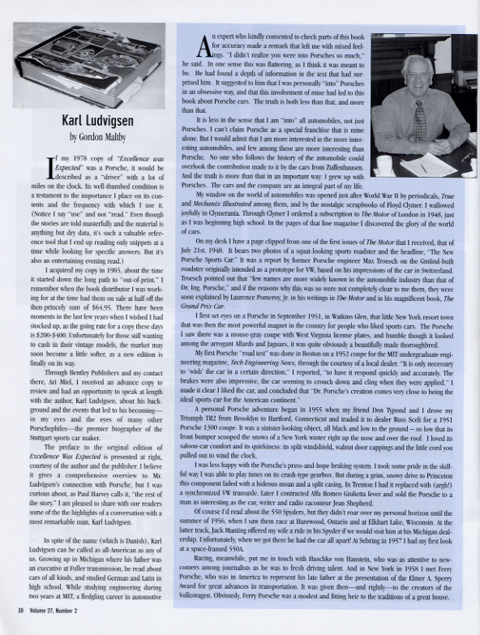
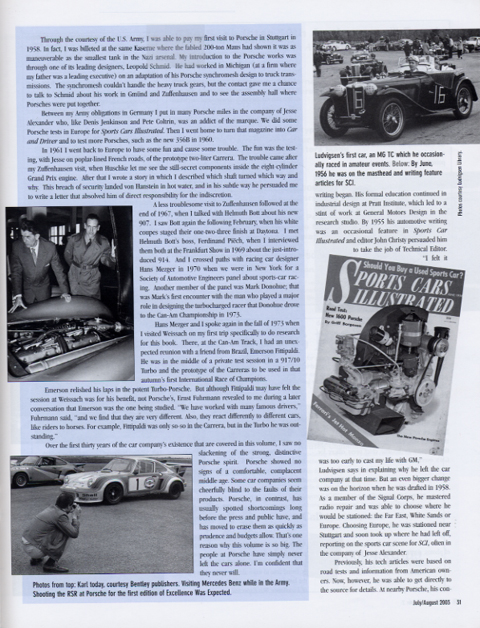
Clockwise from top right: Ludvigsen's first car, an MG TC which he occasionally raced in amateur events. By June, 1956 he was on the masthead and writing feature articles for SCI. Shooting the RSR at Porsche for the first edition of Excellence Was Expected. Visiting Mercedes Benz while in the Army.
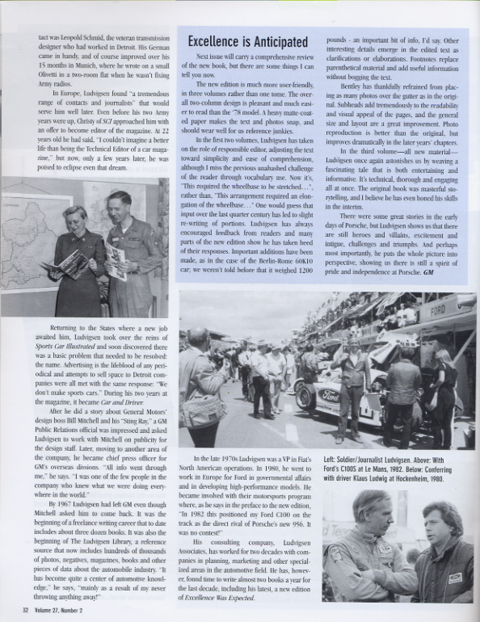
Left: Soldier/Journalist Ludvigsen. Above: With Ford's C100S at Le Mans, 1982. Below: Conferring with driver Klaus Ludwig at Hockenheim,1980.
![[B] Bentley Publishers](http://assets1.bentleypublishers.com/images/bentley-logos/bp-banner-234x60-bookblue.jpg)
